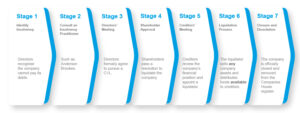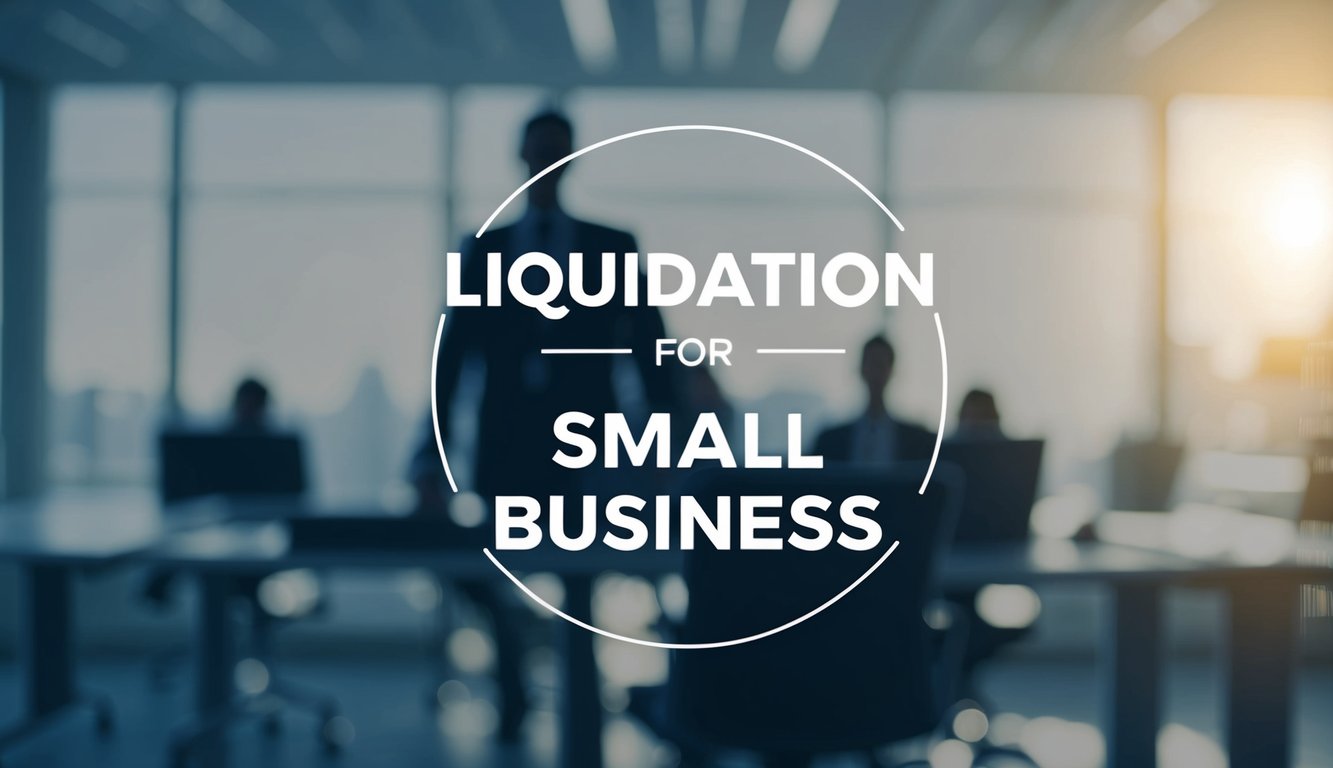Liquidation for Small Business: Essential Steps to Close Your Company Properly
Understanding Liquidation
Liquidation marks the end of a business’s life cycle when it can no longer meet its financial obligations. The process involves selling assets, settling debts, and dissolving the company structure.
Definition and Types of Liquidation
Liquidation occurs when a company ceases operations and converts its assets into cash to pay creditors. This process formally ends the business’s existence.
There are three primary types of liquidation:
- Voluntary Liquidation: Directors choose to close the company, either because it’s insolvent or they wish to retire
- Compulsory Liquidation: Creditors force the company into liquidation through court action
- Members’ Voluntary Liquidation: Solvent companies wind up operations with shareholders’ agreement
Legal Framework for Liquidation in the UK
The Insolvency Act 1986 governs liquidation procedures in the UK, setting strict rules for the process.
A licensed insolvency practitioner must oversee the liquidation process. They take control of company assets and ensure fair distribution to creditors.
The order of payment follows a strict hierarchy:
- Secured creditors
- Preferential creditors (employees)
- Unsecured creditors
- Shareholders
You must notify Companies House and HMRC when entering liquidation. Your company will be struck off the register once the process completes.
Free Consultation – advice@andersonbrookes.co.uk or call on 0800 1804 935 our freephone number (including from mobiles).
Google Reviews

Liquidation for Small Business – Understanding the Fees
When looking at liquidation for small business, the costs are a major concern. Let me break down what you’ll actually pay in straightforward terms.
The first part of liquidation for small business involves the Statement of Affairs fee. This covers all the initial work needed to put your company into liquidation, including preparing documents, notifying creditors, and arranging meetings. You’re looking at roughly £3,000 to £8,000, depending on how complicated your business situation is. If your company has money, it pays. If not, you pay personally.
Then there’s the Liquidator’s fee, which covers everything after that first meeting. Here’s the important bit: if your business has no assets to sell, you don’t pay this fee. That’s right – liquidation for small business doesn’t always mean massive ongoing costs. We still do our job, but you don’t pay unless we recover money from assets.
At Anderson Brookes, we specialise in liquidation for small business and understand keeping costs down matters. We don’t have fancy offices or complicated structures that drive up fees. We’re an SME ourselves, so we get it. While we’re one of the largest insolvency firms by volume, we keep things efficient to ensure liquidation for small business remains affordable.
When you’re already facing the stress of closing your business, the last thing you need is unexpected fees. That’s why we make liquidation for small business costs transparent and keep them as low as possible while still giving you professional service.

Preparing for Liquidation
Proper preparation maximises asset recovery and minimises disruption during the liquidation process. A systematic approach ensures you meet legal obligations whilst protecting stakeholder interests.
Assessing the Financial Position
Start by conducting a thorough review of your company accounts, including profit and loss statements, balance sheets, and cash flow reports.
Create a detailed list of all company assets, including property, equipment, inventory, and accounts receivable. Assign realistic market values to each item.
Document all liabilities, including loans, unpaid taxes, supplier invoices, and employee wages. Rank creditors according to their priority status under UK insolvency law.
Creating a Liquidation Plan
Set clear timelines for each phase of the liquidation process. Include key milestones such as asset valuation, creditor notification, and final dissolution.
Essential Plan Components:
- Asset disposal strategy
- Debt settlement approach
- Staff redundancy arrangements
- Legal compliance checklist
Identify potential buyers for business assets early. Consider whether selling assets individually or as a package will yield better returns.
Communicating with Stakeholders
Draft formal notifications for all stakeholders, including employees, suppliers, customers, and creditors. Be transparent about the timeline and expected outcomes.
Schedule meetings with key stakeholders to address concerns and explain the process. Provide regular updates to maintain trust and cooperation.
Keep detailed records of all communications. This helps prevent misunderstandings and ensures compliance with legal requirements.
Work closely with your insolvency practitioner to ensure all stakeholder communications meet regulatory standards.
You may also like:
Commencing the Liquidation Process
A formal liquidation begins with selecting a qualified insolvency practitioner and submitting the required documentation to Companies House. The timing and specific steps depend on whether you’re pursuing a voluntary or compulsory liquidation.
Choosing a Liquidator
The liquidator must be a licensed insolvency practitioner registered with a recognised professional body in the UK. Contact multiple practitioners to compare their fees and experience with companies similar to yours.
Ask potential liquidators about their specific experience in your industry sector and their success rate with similar cases. Request references from previous clients.
The liquidator’s fees typically come from the company’s assets. Get a clear breakdown of costs before proceeding – these usually include an initial consultation fee, the liquidation process fee, and asset disposal charges.
Filing for Liquidation
Submit form 4.25 (Declaration of Solvency) to Companies House if pursuing a voluntary liquidation. The majority of directors must sign this document in front of a solicitor.
Call a shareholders’ meeting with 14 days’ notice. You’ll need 75% of shareholders to approve the liquidation resolution.
The appointed liquidator will notify all creditors and place an advertisement in The Gazette. They’ll also inform HMRC and any employees about the liquidation proceedings.
Submit all company books, records and assets to your liquidator. They’ll need bank statements, accounts, and asset registers to proceed effectively.
Liquidation – Insolvency Advisory Process – Quick Example

Conducting the Liquidation
The liquidation process requires systematic handling of company assets, settling debts with creditors, and distributing remaining funds according to legal priority. A licensed insolvency practitioner manages these critical steps to ensure compliance with UK regulations.
Asset Realisation
Your appointed liquidator will create a detailed inventory of all company assets. These include physical items like equipment and stock, plus intangible assets such as intellectual property and outstanding invoices.
The liquidator must secure the best possible price for each asset through:
- Professional valuations
- Public auctions
- Private sales
- Debt collection from debtors
Assets are sold at market value or through competitive bidding to maximise returns. Your liquidator maintains detailed records of all sales and transactions.
Debt Settling and Claims Resolution
Creditors must submit formal claims for money owed. Your liquidator will:
- Review and validate all creditor claims
- Determine the order of payment priority
- Negotiate settlements where appropriate
- Handle disputed claims
HMRC and secured creditors typically receive priority payment. Employee claims for unpaid wages and redundancy also take precedence over unsecured creditors.
Distributing Proceeds to Creditors and Shareholders
The distribution follows a strict legal hierarchy:
- Secured creditors with fixed charges
- Liquidation costs and expenses
- Preferential creditors (employees and some HMRC debts)
- Floating charge holders
- Unsecured creditors
Your liquidator provides regular updates on distribution progress. Each creditor receives a percentage of their claim based on available funds.
If any surplus remains after settling all debts, shareholders receive distributions according to their shareholding percentage.
Post-Liquidation Tasks
After your company is liquidated, you must complete several administrative tasks and legal obligations to properly close your business affairs.
Finalising Tax Affairs
You need to inform HMRC about your company’s liquidation status immediately. Submit your final tax returns, including Corporation Tax, VAT, and PAYE.
Required Tax Documentation:
- Final Company Tax Return (Form CT600)
- Final VAT return and VAT deregistration
- Final PAYE submissions
- P45s for all employees
Keep copies of all tax records for at least 6 years after liquidation. HMRC may conduct post-liquidation investigations, so maintaining organised records is crucial.
Deregistering the Company
Your appointed liquidator will handle most deregistration tasks with Companies House, but you have specific responsibilities to fulfil.
Provide all company books, records and documentation to the liquidator. This includes:
- Financial statements
- Bank statements
- Asset registers
- Company contracts
- Employee records
Cooperate with any investigations or queries from the liquidator or regulatory bodies. The liquidator will submit the final paperwork to Companies House, which typically strikes off the company 3 months after receiving the documentation.

Alternatives to Liquidation
Several viable options exist for struggling businesses before choosing liquidation. These alternatives can help you restructure debts, continue trading, or close down your company in a less formal way.
Company Voluntary Arrangement
A Company Voluntary Arrangement (CVA) allows you to make affordable monthly payments to creditors whilst continuing to trade. Your company maintains control of its operations under this formal agreement.
A licensed insolvency practitioner will negotiate with creditors on your behalf to establish payment terms. Typically, this spans three to five years.
CVAs protect your business from creditor pressure and legal action. Creditors cannot pursue additional collection methods once the arrangement is approved.
You must meet the agreed monthly payments to maintain the CVA. Your company needs to demonstrate it can generate sufficient income to fulfil these obligations.
Administration
Administration places your company under the protection of a court order whilst an insolvency practitioner explores rescue options. This process prevents creditors from taking legal action against your business.
The administrator takes control of company operations and assets. Their primary goal is to save the business as a going concern.
Three main outcomes are possible:
- Restructuring the business to restore profitability
- Selling the company as a going concern
- Realising assets for a better return than liquidation
The process typically lasts 12 months but can be extended if necessary.
Dissolution
Dissolution, or striking off, suits companies with straightforward affairs and assets under £25,000. This process removes your company from the Companies House register.
You must cease trading for three months before applying. All creditors and stakeholders require notification of your intention to dissolve.
- No trading activities in the past three months
- No changes to company name
- No legal proceedings pending
- All tax affairs settled
This option costs less than formal liquidation but isn’t suitable for companies with significant debts or complex financial situations.
The Impact of Liquidation
Liquidation creates significant disruption across all levels of a business, affecting both the workforce and leadership team with lasting professional and financial consequences.
Effects on Employees
When your company enters liquidation, your employees face immediate job losses and must seek new employment. You’ll need to process redundancy payments through the National Insurance Fund.
Employees can claim unpaid wages for up to 8 weeks, holiday pay for up to 6 weeks, and statutory notice pay through the government’s Redundancy Payments Service.
Staff members may experience emotional stress and financial uncertainty during this transition period. Many will need to compete for new positions in their industry.
The timing of the announcement is crucial – employees must receive proper notice and clear communication about their rights and entitlements.
Consequences for Directors
As a director, you’ll face scrutiny of your conduct leading up to the liquidation. The insolvency practitioner will investigate your decisions and actions.
You must cooperate fully with the liquidator’s investigation and provide all requested documentation. Any evidence of wrongful trading or breach of director duties could lead to personal liability.
Your role as director will appear on public record, which may affect future business opportunities. Banks and creditors might be hesitant to extend credit or enter business relationships.
If you’ve provided personal guarantees for company debts, creditors can pursue you for payment even after the company closes.

Frequently Asked Questions
Small business liquidation involves specific legal processes, timelines, costs and options that company directors need to carefully consider before proceeding.
What occurs to a director following the liquidation of their firm?
When your company enters liquidation, your powers as a director cease immediately. The appointed liquidator takes control of all company operations and assets.
You maintain the right to start a new business, unless specifically disqualified by the court. Your personal assets remain protected if you’ve acted legally and responsibly as a director.
What is the typical duration for the liquidation process of a small enterprise?
The initial process of placing a company into liquidation typically takes 8-14 days from appointment to commencement.
The full liquidation process, including asset sales and creditor payments, can extend from several months to a year depending on the complexity of your business affairs.
What are the expected costs associated with a company’s liquidation?
Liquidation fees vary based on your company’s size and complexity. Basic liquidations start from £3,000 to £7,000 for small businesses. They can be best – but you are better speaking to us. We can often confirm within the same day and place a business into liquidation within 8!
Additional costs may apply for asset valuations, property sales, or complex creditor negotiations.
What are the primary differences between voluntary and compulsory liquidation?
Voluntary liquidation occurs when you choose to close your solvent or insolvent company. You maintain control over the timing and choice of liquidator.
Compulsory liquidation happens through court order, typically after creditors petition due to unpaid debts. You lose control over the process timing and liquidator selection.
How can a business owner initiate the liquidation of their company independently?
Contact a licensed insolvency practitioner to assess your situation and review options. They’ll guide you through the necessary documentation.
Schedule a shareholders’ meeting to pass the liquidation resolution. The appointed liquidator will handle creditor notifications and asset disposals.
What constitutes the most cost-effective method for a company’s liquidation?
Members’ Voluntary Liquidation offers the most tax-efficient route for solvent companies with assets over £25,000.
For insolvent companies, Creditors’ Voluntary Liquidation typically costs less than waiting for compulsory liquidation proceedings.

